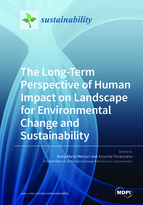The Long-Term Perspective of Human Impact on Landscape for Environmental Change and Sustainability
A special issue of Sustainability (ISSN 2071-1050). This special issue belongs to the section "Environmental Sustainability and Applications".
Deadline for manuscript submissions: closed (30 September 2018) | Viewed by 68111
Special Issue Editors
Interests: palynology; climate change; human impact; cultural landscape; Sahara
Special Issues, Collections and Topics in MDPI journals
Interests: palynology; archaeological sites; pastoralism; cultural heritage; Southern Italy
Special Issues, Collections and Topics in MDPI journals
Special Issue Information
Dear Colleagues,
The knowledge of past environmental history strongly contributes to conscious and efficient environment conservation and management. Therefore, the long-term perspective of the dynamics which govern the human-climate ecosystem is becoming one of the main focuses of paramount interest in biological and earth system sciences. Modern biodiversity is the result of the long-term shaping that humans and climate made on vegetation, soils and landforms. Climate change and human impact are predicted to become significant risks to lose biodiversity.
Multidisciplinary bio-geo-archaeo investigations on the underlying processes of human impact on landscape are crucial to allow us to envisage possible future scenarios of biosphere responses to global warming and biodiversity losses. In particular, palaeoecology and ecology jointly facilitate the understanding of the effects of human impact on ecosystems answering to how plant species have reacted and still react to global changes. Palynology is among the best tools to study high-resolution sequences formed under natural and anthropic (cultural) forces.
This Special Issue seeks to engage an interdisciplinary dialogue on the dynamic interactions between nature and society, focussing on long-term environmental data as essential tool to better-informed landscape management decisions to gain an equilibrium between conservation and sustainable resources exploitation. Studies on environment, global change, archaeobotany, conservation, cultural landscape and human impact, with special focus on the research carried out by botanists in the different fields, are particularly encouraged.
Prof. Dr. Anna Maria MercuriDr. Assunta Florenzano
Guest Editors
Manuscript Submission Information
Manuscripts should be submitted online at www.mdpi.com by registering and logging in to this website. Once you are registered, click here to go to the submission form. Manuscripts can be submitted until the deadline. All submissions that pass pre-check are peer-reviewed. Accepted papers will be published continuously in the journal (as soon as accepted) and will be listed together on the special issue website. Research articles, review articles as well as short communications are invited. For planned papers, a title and short abstract (about 100 words) can be sent to the Editorial Office for announcement on this website.
Submitted manuscripts should not have been published previously, nor be under consideration for publication elsewhere (except conference proceedings papers). All manuscripts are thoroughly refereed through a single-blind peer-review process. A guide for authors and other relevant information for submission of manuscripts is available on the Instructions for Authors page. Sustainability is an international peer-reviewed open access semimonthly journal published by MDPI.
Please visit the Instructions for Authors page before submitting a manuscript. The Article Processing Charge (APC) for publication in this open access journal is 2400 CHF (Swiss Francs). Submitted papers should be well formatted and use good English. Authors may use MDPI's English editing service prior to publication or during author revisions.
Keywords
- Palynology
- Land use change
- Landscape transformation
- Paleoecology
- Archaeology
- Palaeoethnobotany
- Climate change
- Terrestrial Ecology
- Restoration planning
- Environmental Sustainability







